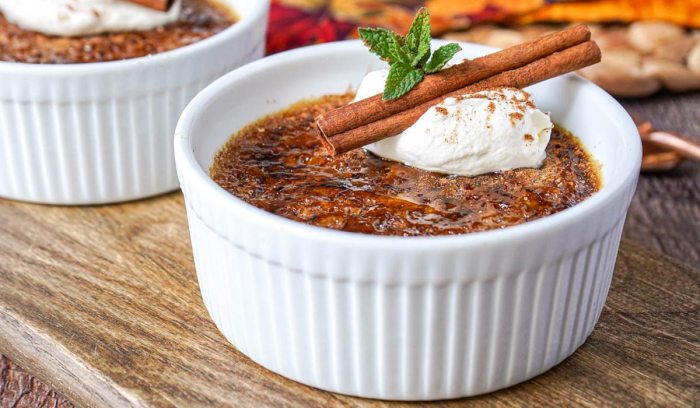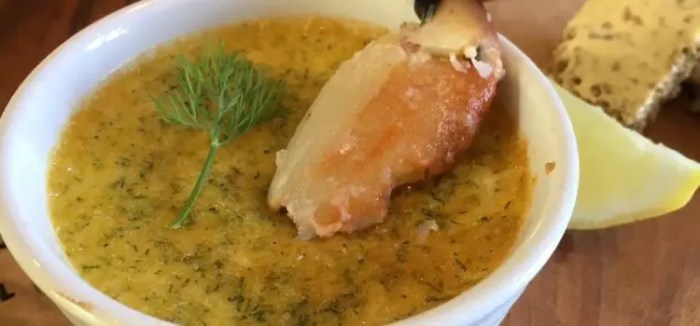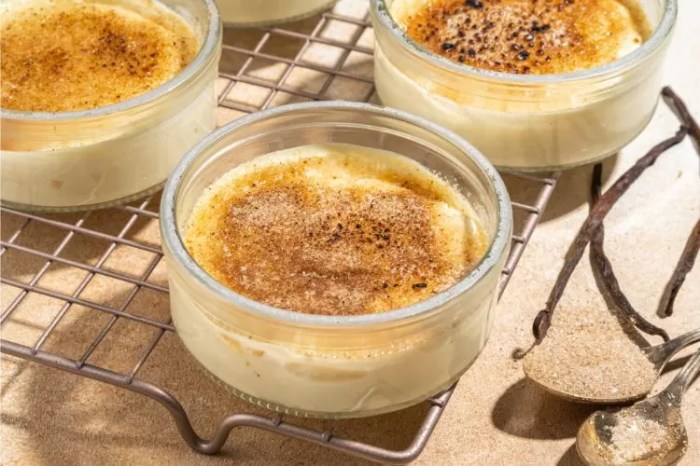
Prepare to embark on a culinary adventure with our crab brulee recipe! This exquisite dish, boasting a harmonious blend of flavors and textures, will leave an unforgettable impression on your palate. Whether served as an appetizer or a main course, crab brulee is a versatile delicacy that promises to delight and amaze.
As we delve into the intricacies of this recipe, we’ll uncover the secrets behind its unique flavor profile, explore its nutritional value, and discover the cultural significance it holds in various cuisines around the world. So, get ready to ignite your passion for cooking and let’s create a masterpiece together!
Introduction to Crab Brulee

Crab brulee, a culinary masterpiece with origins in the coastal regions of France, is a testament to the region’s rich seafood tradition and culinary expertise. This delectable dish has gained immense popularity worldwide, captivating palates with its unique blend of flavors and textures.
Crab brulee combines the succulent sweetness of crab meat with the creamy richness of a custard filling, topped with a golden-brown caramelized crust. The result is a symphony of flavors and textures that tantalizes the senses. Its versatility as an appetizer or main course makes it a perfect choice for various dining occasions.
Cultural Significance
In the coastal regions of France, crab brulee holds a special place in local culinary traditions. It is often served at festive gatherings and special occasions, symbolizing abundance and prosperity. The dish has become an integral part of the region’s cultural identity, reflecting its deep connection to the sea and its bountiful seafood.
Ingredients and Preparation: Crab Brulee Recipe

To craft a delectable crab brulee, you’ll need an array of ingredients that dance together to create a symphony of flavors and textures.
Let’s break down the essential components:
Ingredients
- Crabmeat:The star of the show, fresh or canned crabmeat adds a delicate sweetness and tender texture.
- Eggs:The binding agent that holds the brulee together, eggs provide richness and a velvety texture.
- Heavy cream:This rich dairy ingredient adds a luscious, creamy texture and amplifies the crab’s flavor.
- Dijon mustard:A touch of Dijon adds a subtle tang and depth of flavor.
- Parmesan cheese:Grated Parmesan brings a salty, nutty umami to the mix.
- Fresh herbs (optional):Chopped parsley, chives, or tarragon can add a vibrant pop of color and freshness.
- Salt and pepper:Essential seasonings that enhance the overall flavor profile.
Preparation
Now, let’s embark on the step-by-step process of creating this culinary masterpiece:
- Preheat oven:Set your oven to 325°F (163°C) to create the ideal cooking environment.
- Combine ingredients:In a large bowl, whisk together the crabmeat, eggs, heavy cream, Dijon mustard, Parmesan cheese, herbs (if using), salt, and pepper until well combined.
- Prepare ramekins:Grease individual ramekins with butter or cooking spray to prevent sticking.
- Pour mixture into ramekins:Divide the crab mixture evenly among the prepared ramekins.
- Bake:Place the ramekins in a baking dish filled with hot water (about 1 inch deep) to create a water bath. Bake for 25-30 minutes, or until the brulees are set and slightly golden on top.
- Cool:Allow the brulees to cool for a few minutes before serving.
Presentation and Variations

Crab brulee’s elegant presentation can be elevated with creative garnishes and plating techniques. A sprinkle of chopped chives or dill adds a vibrant touch, while a dollop of caviar or creme fraiche offers a luxurious accent. Plating the brulee in individual ramekins or on a bed of arugula or microgreens creates a visually appealing dish.
Variations
The classic crab brulee recipe can be customized with different crab types, such as Dungeness, blue crab, or king crab, to suit personal preferences. Flavor combinations can also be explored by adding herbs like tarragon or basil, or a touch of citrus zest or smoked paprika.
For a creamy twist, consider incorporating mascarpone cheese or cream cheese into the filling.
If you’re looking for a unique and flavorful dish, consider trying the chicken of the woods recipe . This edible mushroom, also known as Laetiporus sulphureus, has a meaty texture and a slightly tangy flavor that pairs well with various seasonings.
Whether you’re a seasoned chef or a beginner in the kitchen, this recipe is easy to follow and will impress your taste buds.
Nutritional Value and Health Benefits

Crab brulee offers a rich nutritional profile. It is an excellent source of protein, carbohydrates, and fat.
Crab meat is particularly high in protein, which is essential for building and repairing tissues. Carbohydrates provide energy, while fats aid in the absorption of vitamins and minerals.
Omega-3 Fatty Acids
Crab brulee is also a good source of omega-3 fatty acids, which are beneficial for heart health. Omega-3s can help lower blood pressure, reduce inflammation, and improve cholesterol levels.
If you’re looking for a delicious and unique culinary experience, look no further than the chicken of the woods recipe . This edible mushroom has a meaty texture and a slightly sweet flavor, making it a perfect substitute for chicken in a variety of dishes.
Antioxidants, Crab brulee recipe
Crab brulee contains antioxidants, such as astaxanthin and canthaxanthin. These antioxidants can help protect cells from damage caused by free radicals.
Potential Allergens and Dietary Restrictions
Crab is a common allergen, and individuals with shellfish allergies should avoid consuming crab brulee. Additionally, those following a low-fat or low-carbohydrate diet may want to limit their intake of crab brulee due to its high fat and carbohydrate content.
Cultural Impact and Regional Adaptations

Crab brulee holds a significant cultural place in various regions and cuisines worldwide. Its unique flavors and textures have captivated taste buds for centuries, leading to regional variations that showcase the diversity of culinary traditions.
In coastal areas, crab brulee often incorporates fresh, locally caught crab, resulting in a briny and flavorful dish. In inland regions, crabmeat from preserved or canned sources is commonly used, adding a distinct umami quality to the brulee.
Evolution of Crab Brulee
Over time, crab brulee has undergone a culinary evolution. In the past, it was primarily served as a simple dish, with minimal ingredients and seasonings. However, with the influence of modern cuisine, chefs have experimented with innovative flavors and techniques, elevating crab brulee to a sophisticated culinary creation.
Final Review
As we reach the end of our culinary journey, we can’t help but marvel at the versatility and allure of crab brulee. From its humble origins to its contemporary variations, this dish has captivated taste buds across cultures and generations.
Whether you’re a seasoned chef or a home cook looking to impress, crab brulee is a culinary gem that will undoubtedly earn a special place in your repertoire. So, gather your ingredients, embrace your creativity, and let the flavors of crab brulee dance upon your tongue.
Quick FAQs
Is crab brulee difficult to make?
Not at all! With careful preparation and attention to detail, even novice cooks can master this recipe. Our step-by-step guide will provide you with all the necessary instructions to achieve a perfect crab brulee.
Can I use other types of seafood in this recipe?
Absolutely! While crab is the traditional choice, feel free to experiment with other seafood options such as shrimp, lobster, or scallops. The versatility of this recipe allows for endless culinary possibilities.
Is crab brulee a good source of protein?
Yes, crab brulee is an excellent source of protein, providing essential amino acids for your body. It’s a nutritious and satisfying dish that can be enjoyed as part of a balanced diet.





